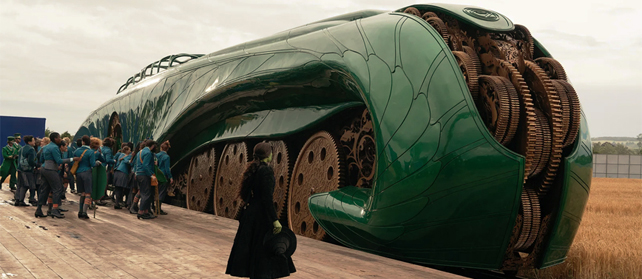Nathan Crowley 2.0

On Wonka, we even had a dedicated chocolatier. You’d go down to their workspace and he’d give you some glorious new thing. You’d often find the producers down in the workshops indulging in the chocolate. Usually everyone on the crew is afraid of our workshops because they seem like scary places with scary people! This can actually be quite advantageous at times! Personally, the workshops are my favorite environment. I thrive on the practical aspects of filmmaking; I think I’d be completely out of my element on a purely CG-driven project.
AS: You mentioned using Unreal Engine, did you ever use it on Volume Stages?
NC: I just used it in the art department where Unreal Engine has been integrated into our workflow, and it’s been transformative. Many of our illustrators have embraced the software, enabling us to create dynamic fly-throughs of our set designs. For example, we can virtually journey through the archway of Shiz, traverse the landscapes we filmed in Southern England, and then soar out to the cliffs. Unreal Engine facilitates the seamless integration of diverse locations, providing the entire team with a clear and compelling vision. I can present a fly-through and say, This represents Seven Sisters in Sussex, and then we transition here to Bournemouth where we’ll construct this particular set piece. So Unreal Engine to me is not about Volumes. For me, the power of Unreal Engine lies in the creation of compelling video presentations, often enhanced with music. The moving image far surpasses static illustrations.
The evolution of our tools is critical. For Wicked, we used a range of technologies, including Unreal Engine, Rhino, 3D printing, traditional miniature and hand model making, and even hand drawing, which some of our senior art directors still utilize. These experienced art directors, who possess a deep understanding of on-set techniques, are invaluable for large-scale set construction.
AS: Do you still do a lot of white card models?
NC: We make every set as a white card model. We even print little miniature people to allow Jon Chu and the crew to plan sequences.
AS: What are your thoughts about the future of production design?
NC: We didn’t use AI on Wicked. Post Wicked, I spent the recent union strike learning Midjourney and what a powerful tool it is but it’s no good if you don’t have imagination. It’s simply one tool among many in our arsenal.
What I find most compelling about AI’s role in the future of design is its ability to streamline the conceptual process. Currently, I leverage AI to rapidly develop and refine mood boards, which then serve as a more precise brief for our illustrators. This has actually enhanced our collaboration with illustrators, not diminished it. We maintain the same number of illustrators on staff, but now I can provide them with clearer direction and a stronger starting point.
AS: Just another way of communicating an idea visually.
NC: At the moment it’s one of the best visual search engines you can imagine. And it’s in Photoshop. And it makes Photoshop so much faster. It’s exciting but I do understand its dangers. What you don’t want is for everything to look similar. The joy of all the designers that are working today is that everything always looks different because we’re all different. And I also don’t want corporations and studios to think, Oh, we don’t need all of you lot anymore, we just press this button and make an utterly boring film. To me AI is just another pencil, it’s a powerful pencil.